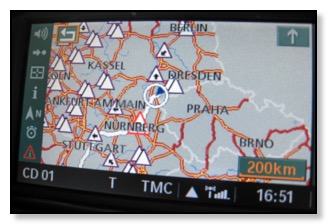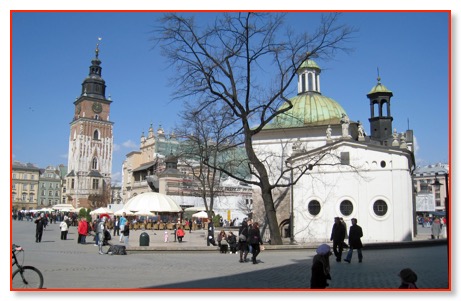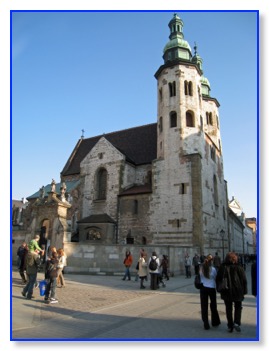Lost my Head in Krakow
(continued)
Miraculously (and eventually) we found ourselves on an actual highway. Because we were finally moving, it was decided that we could snack during the drive. Nazy handed me some seedless grapes and then balanced a Tupperware full of nuts on my thigh. (Note: The photo show’s Claudia’s display - the blank area on the upper right is terra incognita: Poland.)

“I’m sure he’s going to spill this,” Nazy thought.
“That looks dangerous to me,” I thought simultaneously.
At this point, a miniscule muscle tremor in my thigh (or a minute disruption in the planetary gravitational field) imparted an infinitesimal acceleration to the Tupperware. In the resultant confusion, the Tupperware, inverted, hovered long enough for the nuts to plummet – directly into the rails and electronics of the complex BMW seat.
“I knew you were going to do that!” Nazy snorted as she tried to grab the Tupperware in mid-air.
“If you knew, why did you balance it on my thigh?” I asked – pointlessly. “And,” I continued, “When you lunged toward me, you simultaneously launched the cheese slices into the air: they landed in the seat mechanism on the passenger side of the car.”
“We have to stop to clean this up,” Nazy said. “The cheese will stink.”
“Speaking of stinking, my dear, the Persian New Year grass is a bit odoriferous.”
The ‘grass’, called sabsi, had been prepared for the Haft Seen, the Persian New Year table. It was actually sprouted lentils. Tradition says that you should tie knots in the sprouts on the 12th day of the New Year (April 2) and make wishes before discarding the grass in a field. Our grass had begun fermenting after 10 days. It was clear that a rest stop was mandatory.
We couldn’t dislodge the nuts - an industrial strength vacuum, or holes drilled in the floor of the car, might have been sufficient. Nazy eventually extracted the cheese. Finally, with wishes made and grass tied, we discarded the grass and resumed our trip in a less smelly but still not pristine car.
Arriving in the Krakow Old Town, we bounced along cobblestone ‘streets’ looking for the centrally located Stary Hotel. Luckily, Nazy was willing to ask strangers for directions. Unluckily, she was also able to make pertinent observations.
“You should have known that Claudia would be clueless in Poland. Then you would have printed the instructions from the internet and I wouldn’t have to ask random bystanders for assistance.”
In compensation, the hotel clerk upgraded our room and we had dinner at the hotel restaurant (it was too late to go out). Our waiter was normal and the food was great. (Although the restaurant had a Michelin St*r, the invoice was very reasonable.)
The next morning we arose early to see the city.
Krakow has one of the oldest and nicest city centres in Europe. Unlike Warsaw, it was not destroyed in World War II. Fortuitously, the Polish capitol was moved from Krakow several hundred years ago. At the end of WWII, the Яussian army paused outside of Warsaw to allow the Wehrmacht to destroy the city and the resistance before the Russians entered. As you can imagine, Russia is not popular in Poland.

Churches abound in central Krakow. There are three on the main square and others pop every block. The city is heavily Catholic and very, very proud of Pope John Paul II. Moreover, it was the Easter weekend, so the crowds were heavy, the mood happy and the ambiance spectacular. More to the point, the shops and markets were open and the weather, as you’ll see from the photos, was wonderful.
We took a walking tour of the city with an entertaining guide.
“This,” he informed us, pointing to a painting in a anteroom of the Franciscan Church, is the patron saint of Krakow.”
“What did he do?” I asked.
“I’ve done the research – he was not very special.”
“So why is he the patron saint?”
“He was chopped into pieces by a deranged monarch.”
“There must be an easier way to achieve Sainthood,” I thought.
At a “Romanesque Church”, the guide explained that the windows were: “small because the people didn’t trust the construction. Small windows meant stronger walls.”
“That’s absurd!” a Finnish tourist shouted.
“I hate it when engineers join the tours,” the guide thought as he continued: “The churches often served as citadels, the small windows were excellent for defensive purposes.”
We continued to Krakow Castle (Wawel), pausing to visit 3282 churches on the way.

“Queen Jadwiga Jagiellon, one of our most successful monarchs, lived here,” the guide explained. “For some reason she married a 45 year old Lithuanian King when she was 14 years old. She was 6 feet tall, slender and sporty. He was bald..
“Just like you, Dan.” Nazy whispered.
“…. 5 feet, 2 inches tall...”
“And just like you Nazy,” I whispered.
“I am 5 foot 2½, Dan.” Nazy retorted.
“… and bisexual,” the guide concluded.
“Must have been an arranged marriage,” I thought.
Read More

